




IMPORTANT AUSTRALIAN+ INTERNATIONAL FINE ART• SYDNEY• 28 AUGUST 2019
IMPORTANT PRINTS FROM THE GROSVENOR SCHOOL: LOTS 15 - 22
He is a small man with very bright eyes, little bits of sidecurls, and one feels instantly at one’s ease with him. During the summer he lives in a cave in France, a very attractive cave, apparently … and in the winter he comes out of his cave to teach lino-cutting to students of the Grosvenor School.1
This is how the Australian modernist, Dorrit Black, described her teacher Claude Flight, the Englishman who revolutionised printmaking in the 1920s and 30s through his passionate advocacy of the colour linocut. Born in London in 1881, Flight came to art late, enrolling at Heatherley’s School of Art at the age of thirty-one after working in a series of varied professions including bee keeping, farming and engineering. His first colour linocuts were produced around 1919 and, in keeping with the prevailing fashion, used powdered pigment mixed with water brushed onto the printing block in the Japanese style, the aim, to achieve images with delicate colour saturation and subtle gradations of tone that mimicked the effects of watercolour. Soon after however, Flight began to experiment and the first of his colour prints using oil-based inks applied to the linoblock with a hard roller (resulting in denser solid colour) were exhibited in the annual exhibition of the Seven and Five Society in the early 1920s. 2
One of Flight’s best-known prints, Speed , c.1922, was first exhibited in 1922 and exemplifies both his technical and philosophical approach. Combining a boldly designed image in four colours – cobalt blue and yellow ochre (oil paint), vermilion and Prussian blue (printing ink) – from four carved blocks, it is unusual in that it was printed on the reverse of the sheet, the fine translucent paper allowing the colour to show through to the front. 3 Depicting red double-decker buses speeding through a London street, walking figures dwarfed by tall buildings that bend and curve, it evokes the movement and dynamic pace that he perceived as characterising twentieth century life. Flight saw the colour linocut as the modern medium for the modern age, writing that, ‘Time seems to pass so quickly now-a-days. Everybody is in a hurry … this speeding up of life in general … is one of the interesting and psychologically important features of to-day … everybody is on the rush either for work or pleasure: business is hustle, the Cinema, all movement … The Painter cannot but be influenced by the restlessness of his surroundings’. 4
Located in Pimlico in central London, the Grosvenor School of Modern Art was founded in 1925 by Scottish artist, Iain Macnab. It had a decidedly modern outlook, aiming to ‘encourage students to express
their own individual ideas rather than be forced to accept worn-out academic theories’ 5 and to that end, Macnab established a small, hand-picked team of teachers whose forward-thinking ideas matched his own. Various classes were offered, including life drawing, painting, composition, lithography and etching, and from 1926 – 30 Flight taught the art of colour linocutting one afternoon per week. In addition to teaching, he enthusiastically promoted the colour linocut through numerous publications including, Lino-Cuts. A Hand-Book of LinoleumCut Colour Printing (1927), the first major book on the subject which quickly became the standard manual used by artists across the world. Flight was tireless in his promotion of the medium, organising almost annual exhibitions of his and his students’ work between 1929 – 37 in London and touring shows which travelled to regional galleries across Britain, as well as to venues in the United States, China and Australia. The medium received the official stamp of approval in 1929 when prints were purchased from the first group exhibition at London’s Redfern Gallery for the collections of the British Museum and Victoria and Albert Museum in London.
Two of Flight’s colleagues at the school, Cyril Power, an architect and fellow teacher, and Sybil Andrews, the School secretary, joined him in his enthusiasm and commitment to the medium, each becoming skilful exponents of the colour linocut whose work is now highly prized. Power’s c.1932 print, The Tube Station , sits alongside Flight’s Speed in its depiction of a subject that is quintessentially London. A station master waves a full train off on its journey through the Tube, the lights and shadows of the platform creating a crisp geometric pattern that is combined with a series of sweeping curves to once again communicate a strong sense of energy and movement in the image. The Tube Station was printed in five colours – sometimes overlaid to create more variety and depth of colour – and produced in two editions, the first around 1932 numbering sixty impressions, and the second of the same size made for successful exhibitions in America about 1935.
The original print has often been described as a democratic artform, its identical (or near identical) and multiple versions – typically limited in quantity and numbered by the artist – making it more affordable and accessible than unique works of art. Flight imagined that as well as being the medium most suited to contemporary life, the colour linocut would adorn the walls of every home and flat, writing that, ‘Linoleum-art colour prints could be sold … at a price which is equivalent to that paid by the average man for his daily beer or his cinema ticket’. 6 While Flight’s
prints cost much less than a watercolour or more expensive oil painting, typically selling for 2-3 guineas each during the late 1920s, they were still however only within the reach of the middle and upper classes.
Unusually, the Grosvenor School didn’t offer fixed terms but allowed students to join classes at any time during the year and to stay for as long, or short a time, as they wished. This must have been appealing for foreign students and is surely one of the reasons why so many Australians joined the ranks of Grosvenor School alumni. After studying at the South Australian School of Arts and Crafts and later with Julian Ashton in Sydney, Dorrit Black travelled to England in late 1927, attending classes with Flight for several months and absorbing his example of the use of bold colour, the reduction of subject matter to simplified shapes, and patterns based on a dynamic system of opposing rhythmic lines and forms. Bush Wind Mill , 1927 – 28 (sometimes titled The Windmill ) depicts a simple, handmade structure Black knew from a friend’s farm in Western Australia and, pictured beside a small timber outbuilding in the shadow of a tank stand, it proudly declares its rural Antipodean origins. Although this print is said to have been produced in an edition of fifty, as was often the case with relief prints (linocuts and woodcuts) by Australian artists at the time, it is unlikely that the entire edition was ever completed. This is an especially rare print by Black, the only catalogued public holding of it being in the Art Gallery of South Australia.
In 1928 Eveline Syme purchased a copy of Flight’s 1927 book from the Arts and Crafts Society of Victoria and in it, discovered ‘something new and different, lino-cut no longer regarded as a base form of woodcut, but evolved into a distinct branch of 20th Century Art’. She continued, ‘I had seen nothing more vital and essentially modern in the best sense of the word than the reproductions in this book’.7 Soon after she enrolled in linocut classes at the Grosvenor School, following her friend Ethel Spowers who had enrolled at the end of 1928. One of only twentyfive catalogued linocuts by Syme, Sydney Tramline , 1936 uses three colours to describe the path of a tram along a steep Sydney road, past factories, high-rise apartment blocks and terrace houses, terracotta coloured rooftops contrasting with the vivid green of the trees. Creating some of the most lyrical colour linocuts of the period, Ethel Spowers followed Flight’s example of depicting movement, but rather than the speed of the modern machine age, her imagery focussed on slower and more gentle motion, such as sinuous plumes of smoke from picnickers campfires rising through the air as seen in Bank Holiday, 1935 (National Gallery of Victoria, Melbourne) and the sudden blast of air that has sent

CLAUDE FLIGHT AND EDITH LAWRENCE OUTSIDE FLIGHT’S ‘CAVE’ RESIDENCE AT CHANTEMERLE , NEAR PARIS, FRANCE , c.1926 courtesy of Parkin Gallery, London
a bundle of papers flying from the hands of the figure depicted in the delightful print, The Gust of Wind , 1930 – 31.
Although each of Flight’s Australian students found their own subjects and developed a distinctive approach to the medium, together they were instrumental in bringing the ideas and techniques of the colour linocut to Australia and contributing to what was a vital thread within modernism in this country.
1. Black, D., quoted in Coppel, S., Linocuts of the Machine Age: Claude Flight and the Grosvenor School , Scolar Press in association with the National Gallery of Australia, Aldershot, 1995, p. 13
2. Coppel, ibid., p. 12
3. Impressions of Speed were sometimes mounted on yellow-toned paper which shifted the appearance of the printed colours. All technical and edition information in this essay is drawn from the catalogue raisonné by Stephen Coppel, ibid.
4. Flight, C., ‘Dynamism and the Colour Print’, The Original Colour Print Magazine , 2, 1925, p. 56 quoted in Coppel, ibid., p. 17
5. Grosvenor School prospectus quoted in Coppel, ibid., p. 12
6. Flight, C. quoted in Coppel, ibid., p. 19
7. Syme, E., quoted in Butler, R., Printed: Images by Australian Artists 1885 – 1955 , National Gallery of Australia, Canberra, 2007, p. 199
KIRSTY GRANTCLAUD E FLIGHT 15
(1881 – 1955, British) SPEED, c.1922 printed 1929 colour linocut
21.5 x 28.0 cm
edition: (USA) 14/50 signed, numbered and inscribed in image upper left: CLAUDE FLIGHT 14/50 USA
estimate: $25,000 – 35,000
Sold for $48,800 (inc. BP)
PROVENANCE
probably: Joshua McClelland Print Room, Melbourne
Ken and Joan Plomley Collection of Modernist Art, Melbourne
EXHIBITED
Third Exhibition of Painting and Sculpture by the Seven and Five Society, Walker’s Galleries, London, 1922, cat. 65 (another example)
Exhibition of Oils, Watercolours, Lino-Cuts and Sculpture by Claude Flight , The Redfern Gallery, London, 1927, cat. 29 (another example)
Exhibition of Textiles, Drawings and Lino-Cuts by Claude Flight, The Redfern Gallery, London, 1928 Exhibition of Lino-Cuts by Claude Flight , Albany Gallery, London, 1932, cat. 28 (another example)
Exhibition of Modern Colour Prints, National Gallery of Canada, Ottawa, 1935 – 36, cat. 33 (another example, as ‘Speed, London Bus’)
Exhibition of Modern Lino-Cuts , City of Birmingham Museum and Art Gallery, Birmingham, 1939, cat. 65 (another example) Colour Lino-Cuts , Arts Council of Great Britain, London, 1947, cat. 29 (another example)
Out of the Book and On to the Wall: The Relief Print , Australian National Gallery, Canberra, 20 February – October 1984 (another example, UK edition) Claude Flight and His Followers: The Colour Linocut Movement bet ween the Wars , National Gallery of Australia, Canberra, 18 April – 18 July 1993 and travelling, cat. 33 (another example, USA edition)
Dynamism and Colour: British linocuts of the 1930s , Museum of New Zealand, Te Papa Tongarewa, Wellington, 20 August 2009 – 15 February 2010 (another example, USA edition)
Drawings and Prints: Selections from the Permanent Collection , The Metropolitan Museum of Art, New York, 29 April – 14 July 2014 (another example, UK edition)
Rutter, F., Sunday Times , London, 12 June 1927
Konody, P. G., Observer, London, 19 June 1927, p. 14
Laver, J., ‘Recent Etching and Engraving’, Artwork , London, vol. 3, no. 11, September – November 1927, p. 151 ‘Flight’s Method of Depicting Motion’, The Philadelphia Inquirer, Philadelphia, 25 January 1925, p. 71
Flight, C., Lino-cuts: A hand-book of linoleum-cut colour printing , John Lane, the Bodley Head, London, 1927, pl. 1 (and illus. frontispiece, another example)
Konody, P.G., Daily Mail, 8 November 1928
Parkin, M., ‘Claude Flight and the Linocut’, The Journal of Decorative and Propaganda Arts, vol. 6, Autumn 1987, fig. 2, pp. 28, 29 (illus., another example, dated as c.1922, UK edition)
Carey, F., and Griffiths, A., Avant-Garde British Printmaking 1914 – 1960, British Museum, London, 1990, cat. 54, p. 76 (illus., another example)
Coppel, S., Linocuts of the Machine Age: Claude Flight and the Grosvenor School, Scolar Press, Aldershot, England, in association with the National Gallery of Australia, Canberra, 1995, cat. CF7, pl.2, pp. 12, 18, 20, 74, 75 (illus., another example, USA edition)
Corbett, D., The Modernity of English Art 1914 – 1930, Manchester University Press, New York, 1997, fig. 18, p. 84 (illus., another example)
Ackley, C. S.(ed.), Rhythms of Modern Life: British Prints 1914 – 1939 , Museum of Fine Arts Boston, 2008, cat. 46, pp. 95, 102, 215
Gulliver, K., and Tóth, H., Cityscapes in History: Creating the Urban Experience , Routledge, London and New York, 2016, fig. 6.3, p. 128 (illus., another example, USA edition)
Other examples of this print are held in the collection of the Victoria and Albert Museum, London (UK edition); The Metropolitan Museum of Art, New York (UK edition); The National Gallery of Australia, Canberra (USA edition); Mus eum of New Zealand, Te Papa Tongarewa, Wellington (US A edition), and the Art Gallery of South Australia, Adelaide (UK edition)
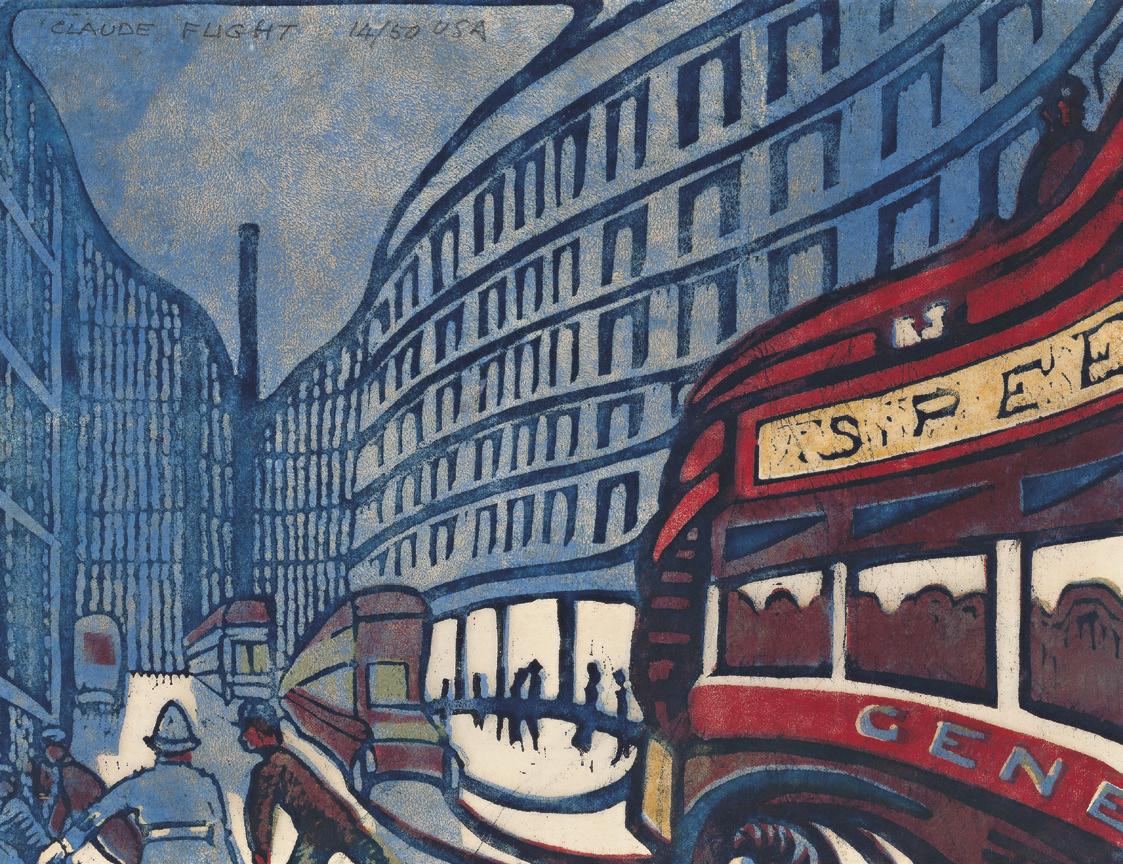
CYRIL POWER 16
(1872 – 1951, British)
THE TUBE STATION, c.1932
colour linocut
26.5 x 29.5 cm
edition: (UK) 23/60
signed, numbered and inscribed with title in image lower right: “The Tube Station’ / No. 23/60 Cyril E Power
estimate: $25,000 – 35,000
Sold for $58,560 (inc. BP)
PROVENANCE
probably: Joshua McClelland Print Room, Melbourne
Ken and Joan Plomley Collection of Modernist Art, Melbourne
EXHIBITED
Modern Colour Prints, Redfern Gallery, London, 21 July – 20 August 1932, cat. 2 (another example)
Modern Colour Prints and Wood Engravings from the Redfern Gallery, Old Bond Street, London, Collins House, under the auspices of the Arts and Crafts Society of Victoria, Melbourne, 7 – 23 December 1932, cat. 28 (another example)
Out of the Book and On to the Wall: The Relief Print , Australian National Gallery, Canberra, 20 February – October 1984 (another example, US edition)
The Grosvenor School. British Linocuts Between the Wars, Museum of Art, Rhode Island School of Design, and touring, cat. 45 (illus. in exhibition catalogue, p.67, another example, US edition)
Avant Garde British Printmaking 1917 – 1960, British Museum, London, September 1990 – January 1991 (another example)
Rhythms of Modern Life: British Prints 1914 – 1939, Mu seum of Fine Arts, Boston, 30 January – 1 June 2008 and touring, cat. 49 (another example)
Modern Britain 1900 – 1960 , National Gallery of Victoria, Me lbourne, 15 November 2007 – 24 February 2008 (another example, USA edition)
Speed and Flight, Auckland Art Gallery Toi O Tamaki, Auckland, 14 April – 15 July 2012 (another example, US edition)
Other examples of this print are held in the collections of the Metropolitan Museum of Art, New York (UK edition); National Gallery of Victoria, Melbourne (USA edition); Auckland City Art Gallery, Auckland (USA edition) and the Art Gallery of Ontario, Ontario (USA edition)
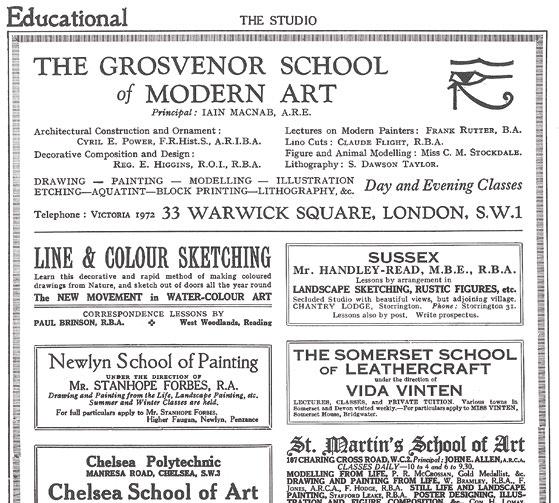
GROSVENOR SCHOOL ADVERTISEMENT, The Studio, London, August 1926
‘Redfern Gallery’, The Times , London, 23 July 1932, p. 8
Rutter, F., ‘Modern Colour Prints. A Democratic Art’, The Sunday Times , London, 7 August 1932, p. 5
Coppel, S., Linocuts of the Machine Age: Claude Flight and the Grosvenor School , Scolar Press, Aldershot, England, in association with the National Gallery of Australia, Canberra, 1995, cat. CEP 32, pp. 98 – 99 (illus., another example)
Vann, P., Cyril Power Linocuts: A Complete Catalogue , Lund Humphries, Farnham, 2008, cat. 32, p. 85 (illus., another example, USA edition)
Ackley, C.S. (ed.), British Prints from the Machine Age: Rhythms of Modern Life 1914 – 1939 , Thames and Hudson, London, 2008, cat. 49, pp. 94, 215 (illus. front cover and p. 105, another example)

(1890 – 1947)
THE GUST OF WIND, 1930 – 31 colour linocut 22.0 x 16.5 cm
edition: 16/50
signed, dated, numbered and inscribed with title below image
estimate: $30,000 – 40,000
Sold for $36,600 (inc. BP)
Joshua McClelland Print Room, Melbourne Ken and Joan Plomley Collection of Modernist Art, Melbourne, acquired from the above in May 1982
The Artists’ Society of Canberra, Third Annual Exhibition , Sydney Buildings, Canberra, 14 – 28 March 1930, cat. 87 (another example, as ‘The Newsboy’) Exhibition of Linocuts , Everyman’s Lending Library, Melbourne, 10 – 24 December 1930, cat. 25 (another example, as ‘The Newsboy’) Third Exhibition of British Lino-Cuts , Redfern Galleries, London, August 1931, cat. 2 (another example) Macquarie Galleries, Sydney, 1932, cat. 41 Exhibition of Linocuts , Everyman’s Lending Library, Melbourne, 5 – 16 April 1932, cat. 17 (another example) Gladys Owen and Ethel Spowers. Lino-cuts, Wood-cuts and Watercolours , Grosvenor Galleries, Sydney, 1932, cat. 3 (another example)
Exhibition of Colour Prints and Water Colours by Ethel Spowers , Grosvenor Galleries, Sydney, 10 – 25 July 1936, cat. 3 (another example) BA, Melbourne, 1937, cat. 70 Melbourne Woodcuts and Linocuts of the 1920’s and 1930’s , Ballarat Fine Art Gallery, Victoria, 1981, and travelling (illus. in exhibition catalogue) Elyse Lord, Thea Proctor, Ethel Spowers, Margaret Preston, Joshua McClelland Print Room, Melbourne, 20 – 30 April 1982, cat. 4 Out of the Book and On to the Wall: The Relief Print , Australian National Gallery, Canberra, 20 February – October 1984 (another example)
The Grosvenor School. British Linocuts Between the Wars , Museum of Art, Rhode Island School of Design, 22 January – 20 March 1988; Cleveland Museum of Art, 9 August – 2 October 1988; Santa Barbara Museum of Art, 22 O ctober – 18 December 1988, cat. 46 (illus. in exhibition catalogue, p. 67 another example)
Claude Flight and His Followers: The Linocut Movement between the Wars, Australian National Gallery, Canberra, 18 April – 12 July 1992, and touring, cat. 78 (another example)
The work of art: Australian women writers and artists, State Library of New South Wales, Sydney, 14 August 1995 – 11 February 1996 (another example) Modern Australian Women: Paintings and Prints 1925 – 1945, Art Gallery of South Australia, Adelaide, 24 November 2000 – 25 February 2001, and touring (another example)
Sydney Moderns: Art for a New World, Art Gallery of New South Wales, Sydney, 6 July – 7 October 2013, (another example)
Streeton, Argus , Melbourne, 9 December 1930, p. 5 (as ‘The Newsboy’) Times , London, 13 July 1931
Streeton, Argus , Melbourne, 5 April 1932 ‘Gladys Owen and Ethel Spowers. Lino-cuts, Wood-cuts and Watercolours’, Sydney Morning Herald, Sydney, 6 December 1932, p. 4 Butler, R., and Deutscher, C., A Survey of Australian Relief Prints 1900/1950 , Deutscher Galleries, Melbourne, 1978, cat. 161, pp. 72, 84 (illus., another example)
Coppel, S., Linocuts of the Machine Age: Claude Flight and the Grosvenor School, Scolar Press, Aldershot, England, in association with the National Gallery of Australia, Canberra, 1995, pl. 35, cat. ES15, pp. 37, 66, 67, 170, 171 (illus., another example)
Mendelssohn, J., ‘Women’s Work’, The Australian , 25 August 1995, p. 15 (illus., another example)
Hylton, J., Modern Australian Women: Paintings and Prints 1925 – 1945 , Art Gallery of South Australia, Adelaide, 2000, pp. 56, 58 (illus., another example), 126
Edwards, D., and Mimmocchi, D. (eds.), Sydney Moderns: Art for a New World, exhibition catalogue, Art Gallery of New South Wales, Sydney, 2013, pp. 178 (illus., another example), 316
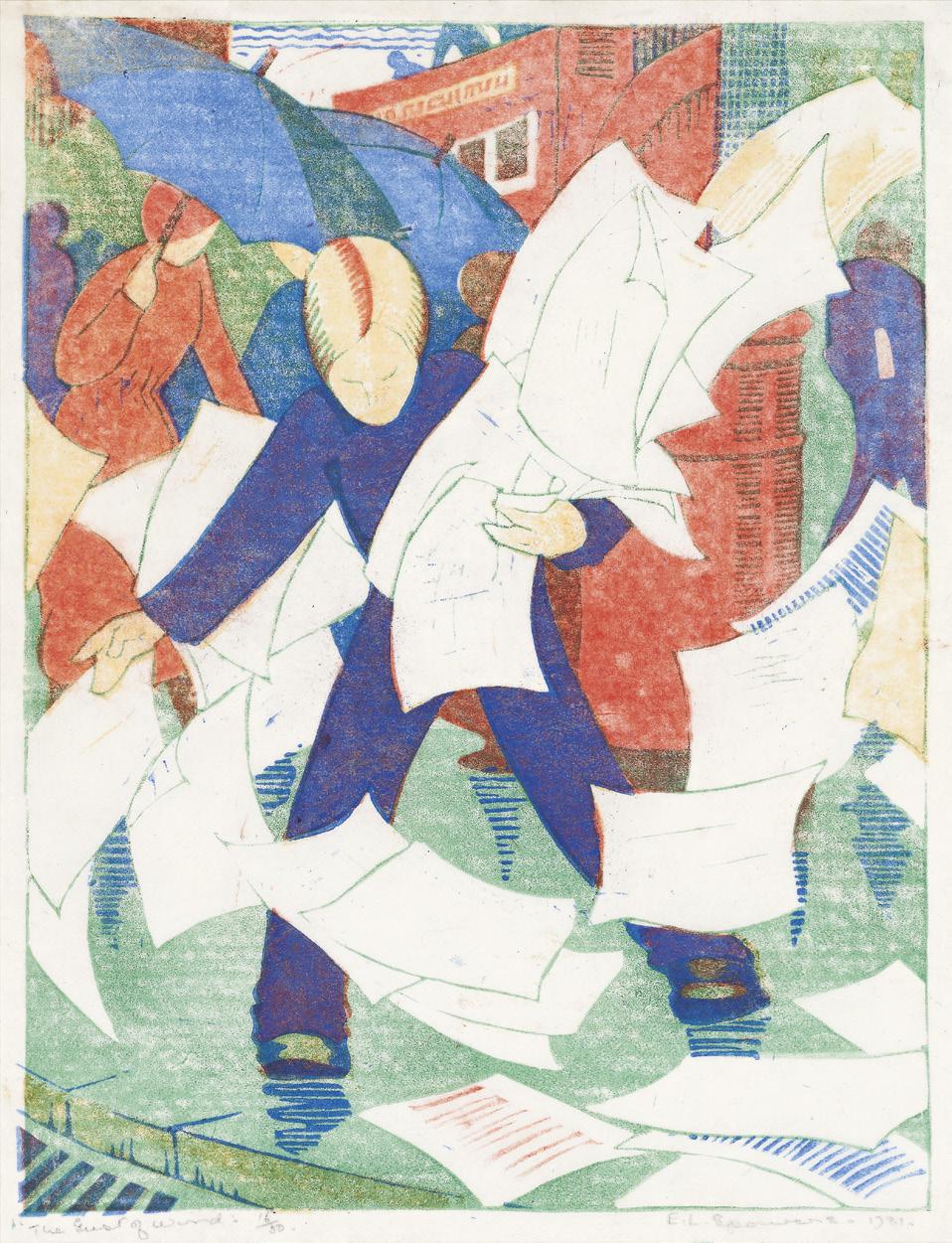
(1888 – 1961)
SYDNEY TRAMLINE, 1936 colour linocut
24.5 x 18.0 cm
edition: 4/25
signed, numbered and inscribed with title below image
estimate: $15,000 – 20,000
Sold for $25,620 (inc. BP)
PROVENANCE
probably: Joshua McClelland Print Room, Melbourne
Ken and Joan Plomley Collection of Modernist Art, Melbourne
EXHIBITED
Exhibition of Pictures by the Contemporary Group of Artists , David Jones’ Galleries, Sydney, July 1937, no. 93 (another example)
A Survey of Australian Relief Prints 1900/1950 , Deutscher Galleries, Melbourne, 13 April – 5 May 1978, cat. 180 (another example)
Melbourne Woodcuts and Linocuts of the 1920’s and 1930’s , Ballarat Fine Art Gallery, Victoria, 1981, and travelling (another example)
Out of the Book and On to the Wall: The Relief Print , Australian National Gallery, Canberra, 20 February – October 1984 (another example)
Claude Flight and His Followers: The Linocut Movement between the Wars, Australian National Gallery, Canberra, 18 April – 12 July 1992, and touring, cat. 100 (another example)
Modern Australian Women: Paintings and Prints 1925 – 1945, Art Gallery of South Australia, Adelaide, 24 November 2000 – 25 February 2001, and touring (another example)
Sydney Moderns: Art for a New World, Art Gallery of New South Wales, Sydney, 6 July – 7 October 2013, (another example)
Butler, R., and Deutscher, C., A Survey of Australian Relief Prints 1900/1950 , Deutscher Galleries, Melbourne, 1978, cat. 180, pp. 91, 118 (illus., another example)
Butler, R., Melbourne Woodcuts and Linocuts of the 1920’s and 1930’s , Ballarat Fine Art Gallery, Victoria, 1981, unpaginated (illus., another example)
Coppel, S., Linocuts of the Machine Age: Claude Flight and the Grosvenor School, Scolar Press, Aldershot, England, in association with the National Gallery of Australia, Canberra, 1995, pl. 43, cat. ESy20, pp. 184 – 185 (illus., another example)
Hylton, J., Modern Australian Women: Paintings and Prints 1925 – 1945 , Art Gallery of South Australia, Adelaide, 2000, pp. 57, 81 (illus., another example), 126 Edwards, D., and Mimmocchi, D. (eds.), Sydney Moderns: Art for a New World, exhibition catalogue, Art Gallery of New South Wales, Sydney, 2013, pp. 71 (illus., another example), 316
Other examples of this print are held in the collections of the National Gallery of Australia, Canberra; the Art Gallery of New South Wales, Sydney; and the Ballarat Fine Art Gallery, Victoria

DORRIT BLACK 19 (1891 – 1951)
BUSH WIND MILL, 1927 – 28 colour linocut
26.0 x 23.0 cm
edition: 10/50 numbered below image
estimate: $10,000 – 15,000 Sold for $48,800 (inc. BP)
possibly: Theodore Bruce, Adelaide, 15 June 1986, lot 96 (as ‘Watertank and Windmill’)
Ken and Joan Plomley Collection of Modernist Art, Melbourne
EXHIBITED
Dorrit Black, Macquarie Galleries , Sydney, 10 – 2 0 September 1930, cat. 24 (another example, as ‘Bush Wind Mill’)
Exhibition of Linocuts, Everyman’s Lending Library, Melbourne, 5 – 16 April 1932, cat. 5 (another example)
Drawing, Print and Watercolour, Contemporary Arts Society, Adelaide, 1952, cat. 29 (another example)
Claude Flight and His Followers: The Linocut Movement between the Wars , Australian National Gallery, Canberra, 18 April – 12 July 1992 and touring, cat. 21 (another example, as ‘Bush Wind Mill, c.1930’)
Modern Australian Women: Paintings and prints 1925 – 1945 , Art Gallery of South Australia, Adelaide, 24 November 2000 – 25 February 2001, and touring (another example)
Dorrit Black , Unseen Forces, Art Gallery of South Australia, Adelaide, 14 June – 7 September 2014 (another example, as ‘The Windmill’)
‘Miss Dorrit Black’s Pictures’, Sydney Morning Herald , Sydney, 11 September 1930, p. 7 (as ‘Bush Windmill’)
‘Tribute to Artist’, The Advertiser, Adelaide, 2 December 1952, p. 9
‘Unusual Sculpture for National Gallery’, The Advertiser, Adelaide, 24 December 1952, p. 5
North, I., The Art of Dorrit Black, Art Gallery of South Australia and Macmillan, Adelaide, 1979, cat L.11, p.131 (as ‘Bush Wind Mill, c.1930’)
Coppel, S., Linocuts of the Machine Age: Claude Flight and the Grosvenor School , Scolar Press, Aldershot, England, in a ssociation with the National Gallery of Australia, Canberra, 1995, cat. DB11, pp. 154 – 155 (illus., another example, as ‘Bush Wind Mill, c.1930’)
Hylton, J., Modern Australian Women: Paintings and prints 19 25 – 1945 , exhibition catalogue, Art Gallery of South Australia, Adelaide, 2000, pp. 57 (illus.), 58, 121 (another example, as ‘Bush Windmill, c.1930’)
Lock-Weir, T., Dorrit Black: Unseen Forces , exhibition catalogue, Art Gallery of South Australia, Adelaide, 2014, pp. 160, 162 (illus.), 199 (illus., another example)
Another example of this print is held in the collection of the Art Gallery of South Australia, Adelaide
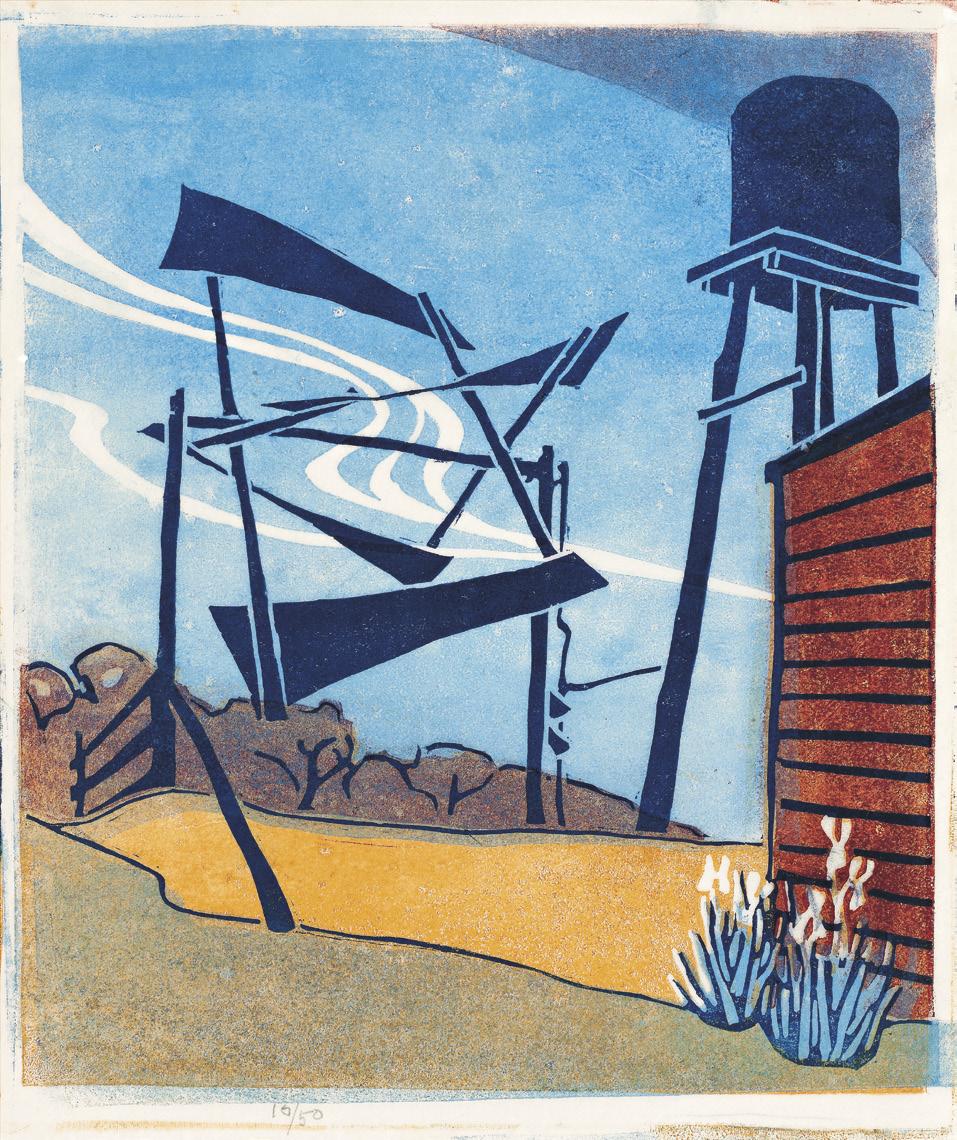
ETHEL SPOWERS 20 (1890 – 1947)
MELBOURNE FROM THE RIVER, c.1924
colour woodcut
19.0 x 22.5 cm
edition: 6/20
signed, numbered, and inscribed with title below image
estimate: $10,000 – 15,000
Sold for $34,160 (inc. BP)
PROVENANCE
possibly: Joshua McClelland Print Room, Melbourne Ken and Joan Plomley Collection of Modernist Art, Melbourne
EXHIBITED
Victorian Artists Society, Melbourne, Spring 1924, no. 235 (as ‘Town from the River’)
Exhibition of Works by Ethel Spowers, The New Gallery, Melbourne, 4 – 15 August 1925, cat. 36 (another example)
LITERATURE
‘Art Notes. Watercolours by Miss Ethel Spowers’, The Age, Melbourne, 4 August 1925, p. 9 ‘The Studio. Miss Spowers’ Watercolours’, The Australasian , Melbourne, 8 August 1925, p. 44 Coppel, S., Linocuts of the Machine Age: Claude Flight and the Grosvenor School , Scolar Press, Aldershot, England, in association with the National Gallery of Australia, Canberra, 1995, cat. ES A/7, p. 189
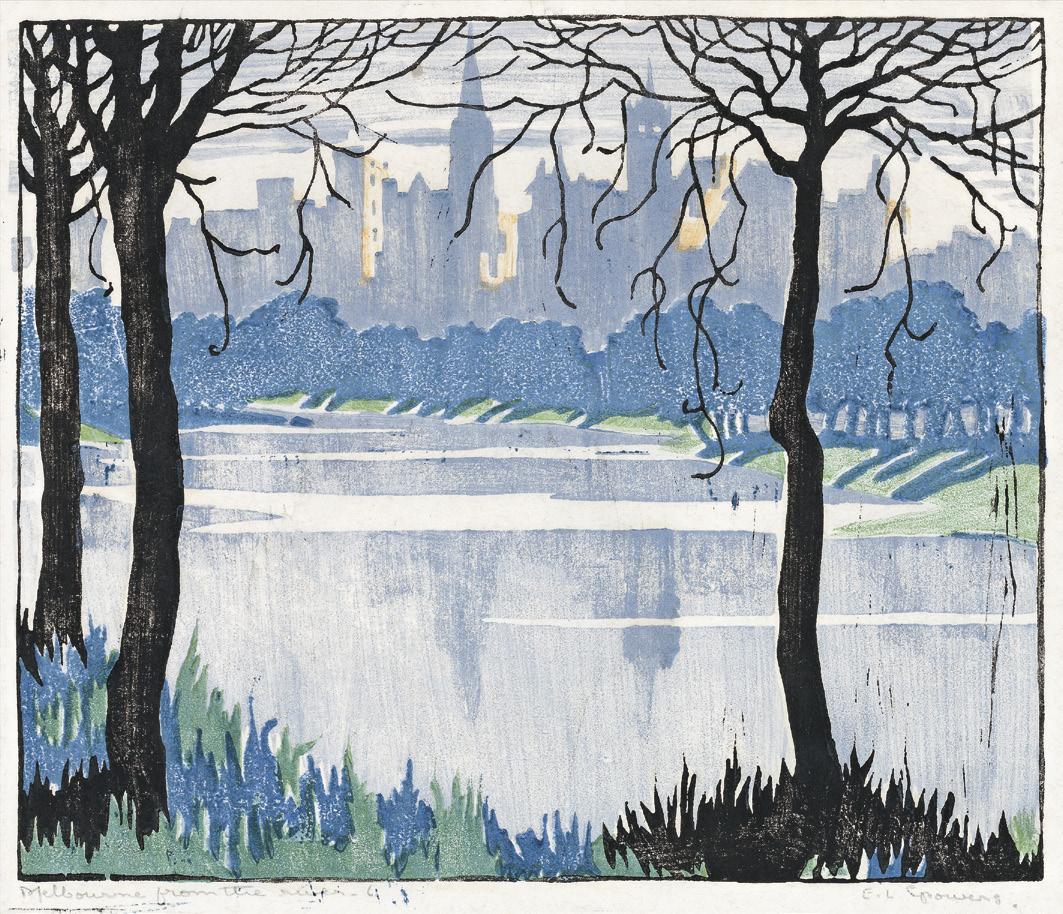
CLAUDE FLIGHT 21
(1881 – 1955, British)
DESCENT FROM THE BUS, c.1927
colour linocut
31.5 x 15.5 cm
edition: 8/50
signed and numbered lower right within image: CLAUDE FLIGHT 8/50
Joshua McClelland Print Room, Melbourne (as ‘Design for a Window’) Ken and Joan Plomley Collection of Modernist Art, Melbourne, acquired from the above in July 1980
Exhibition of Oils, Watercolours, Lino-Cuts and Sculpture by Claude Flight , The Redfern Gallery, London, 1927, cat. 32 (another example)
Exhibition of Lino-Cuts by Claude Flight, R.B.A , Albany Gallery, London, 1931, cat. 4 (another example, as ‘Descent from Omnibus’) British Printmakers 1812 – 1940 , Mathiesen Fine Art, London, December 1979 (another example) Out of the Book and On to the Wall: The Relief Print , Australian National Gallery, Canberra, 2 0 February – October 1984 (another example) The Grosvenor School. British Linocuts Between the Wars , Museum of Art, Rhode Island School of Design, 22 January – 20 March 1988; Cleveland Museum of Art, 9 August – 2 October 1988; Santa Barbara Museum of Art, 22 October – 18 December 1988, cat. 20 (illus. in exhibition catalogue, p. 27) Claude Flight and His Followers: The Colour Linocut Movement between the Wars , National Gallery of Australia, Canberra, 18 April – 18 July 1993 and touring (another example) British Modern Prints from the British Museum: from the Great War to the Grosvenor School , University of San Diego, San Diego, 10 February – 19 May 2017 (another example)
Konody, P. G., Observer, London, 19 June 1927, p. 14 Laver, J., ‘Recent Etching and Engraving’, Artwork , London, vol. 3, no. 11, September – November 1927, p. 151 Coppel, S., Linocuts of the Machine Age: Claude Flight and the Grosvenor School, Scolar Press, Aldershot, England, in association with the National Gallery of Australia, Canberra, 1995, cat. CF22, pl.7, pp. 78 (illus., another example)
estimate: $4,000 – 6,000 Sold for $14,640 (inc. BP)
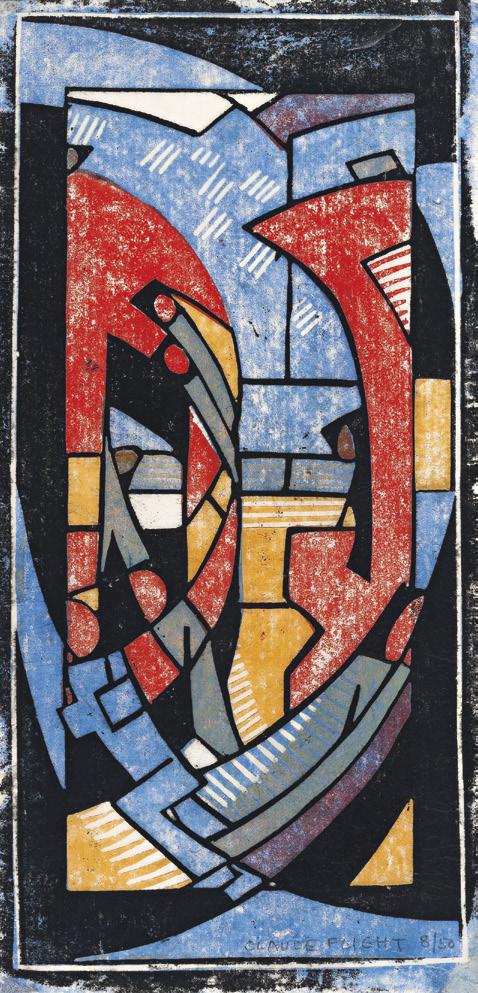
Other examples of this print are held in the collections of the British Museum, London and the National Gallery of Australia, Canberra

MAYO 22 (1906 – 1994)
SPANISH KITCHEN, c.1945
colour lithograph
35.0 x 28.0 cm
edition: 17/25
signed, numbered and inscribed with title below image
estimate: $1,000 – 2,000
Sold for $2,440 (inc. BP)
Private collection
Christie’s, Melbourne, 2 December 1991, lot 146
Ken and Joan Plomley Collection of Modernist Art, Melbourne
RELATED WORK
Another example of this print is held in the collection of the National Gallery of Australia, Canberra